- Help staff members foster healthy relationships among children.
- Help staff members foster healthy relationships with families.
- Describe and use strategies that reflect active listening, respectful speaking, and conflict resolution.
- Observe and provide feedback to staff members about developing healthy relationships among children, staff, and families in your program.
Learn
Teach
Imagine your best friend was asked to create a video testimonial about your friendship. What nice things would he or she say about you? What events would he or she capture on photos or videos to portray your friendship? The evidence or events that come to mind represent your friendship, but they also represent the ways you build relationships with others in your personal and professional life. Friends take an interest in one another’s preferences, interests, and backgrounds. They regularly do little things that make a difference to the other person: call or text just to check in, compliment a new haircut, share a meal, babysit a child, give a ride, or lend a hand when needed.
Many difficulties in relationships can be changed when we consider how our own behavior may be causing or contributing to problems. When we work toward building positive relationships, our influence on the behavior of others begins to grow exponentially. Unconditional acceptance of children and others in your program not only builds a strong relationship, but also encourages them to have confidence and trust in themselves. It’s important that we learn to separate who someone is as a person from what they do. Remember, behaviors can always change.
This lesson will focus on four types of relationships: relationships between children, relationships between children and adults, relationships between your staff and families, and relationships among staff members in your program.
Healthy Relationships Between Children
As a trainer or coach, you can ensure that children have ample opportunities to develop and practice important relationship-building activities with each other. You can do this by offering activity and play buddies, noticing friendly interactions, giving specific praise, suggesting play ideas, and monitoring interactions. Each one of these strategies is explored in more depth below.
Offering Activity and Play Buddies
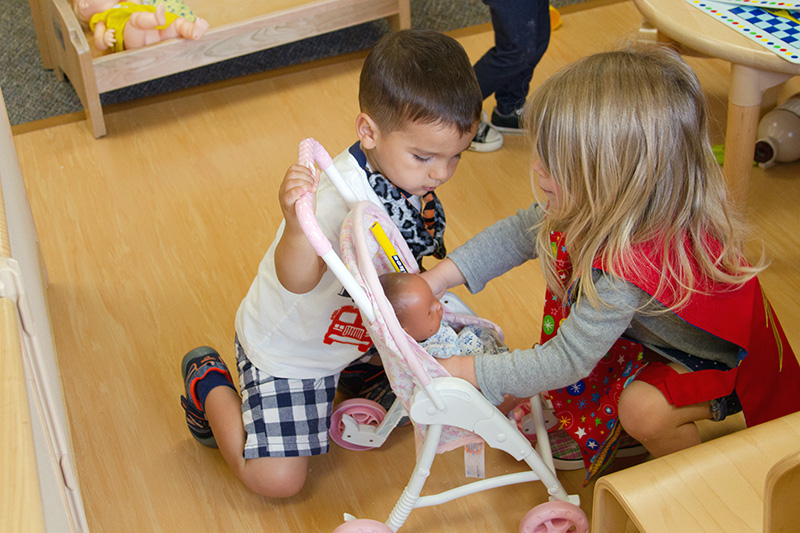
Activity and play buddies are an excellent way to embed friendship opportunities throughout the day. Assign children as greeters, plan activities that require a partner, organize games that are inclusive regardless of ability level, select books that have friendship themes, and incorporate compliment circles at the start and end of the day (Joseph & Strain, 2003). Efforts should be made to regularly rotate activity and play buddies to provide a variety of experiences. Rotating ensures that children have opportunities to engage in friendship skills with a wide variety of playmates and personality types. This is particularly helpful when pairing more popular or well-liked children with those who are not as social. Here are a few examples of what activity and play buddies might look like at each age group:
- Infants: Two 6-month-old infants sit across from each other on the play mat. An adult helps roll a ball back and forth between them. The adult makes comments throughout the interaction about the infants’ behavior: “You’re so happy Jamil rolled you the ball,” “Now it’s April’s turn,” or “You two are playing together.”
- Toddlers: Children are paired up for a cooperative song. Two children sit facing each other, hold hands, and rock each other back and forth as if rowing a boat. Everyone sings “Row, Row, Row your Boat.”
- Preschool: The class makes a “friendship snack.” In small groups, each child is given an ingredient for a simple recipe (trail mix, fruit salad, etc.). The children work together to make their friendship snack, and the adult talks about working together to make a better snack.
- School-age: The program creates a Gratitude Board. Whenever a child or staff member does something nice for another person, that person writes a note about it on a card and posts it on the board. The board is regularly reviewed and talked about among the children and staff.
This video provides additional examples of ways staff members can promote friendship:
Helping Children Build Healthy Relationships
Noticing Friendly Interactions
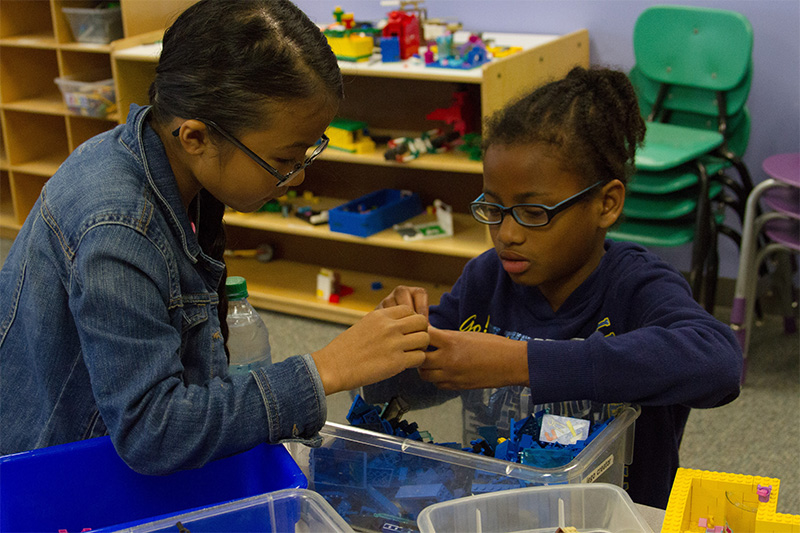
Whenever you are in classrooms or program spaces, look for children who are being good friends or helpful peers. Genuine, kind comments about such behaviors can help build a climate of respect and appreciation. You and staff members can also help children notice the positive impacts of their behaviors on others. For example, you might notice and describe interactions like, “Jamal, I noticed you made room for Phoebe at the water table. She looks really excited to play with you. Thank you for making room.” Here are a few more examples:
- Infants and toddlers: A teacher comments positively when a child offers another child a toy. “Camilla gave Tony a ball. Look at his face. He is so happy.”
- Preschool: During a buddy activity, a teacher intentionally pairs an outgoing child with a child who tends to be more reserved. The teacher stays close and comments on the partner’s interactions. She helps narrate or describe each partner’s behavior, “Look, Valerie, Sonya offered you the hammer and said it’s your turn. She wants to work together.”
- School-age: The program begins a Citizen of the Week program. Children are nominated by their peers. Each week, a child is featured who has shown exemplary citizenship and friendship behaviors. The behaviors are described on a bulletin board with the child’s picture.
Suggesting Play Ideas
Children begin to understand another’s perspective and feelings through play. Play allows them to learn skills for entering a group, following rules, fairness, honesty, imagination, making decisions, showing leadership, problem solving, negotiation, compromising, and sharing (Leyden & Shale, 2012). If a child is having difficulty showing leadership, you may ask them to suggest a game to play with a partner. If a child is having trouble compromising, a game that encourages collaboration and teamwork could help them see how their ideas, when combined with the ideas of others, can benefit the group as a whole. Here are a few examples of this strategy for children of different ages:
- Infants: An infant crawls over to where an adult and infant are building with fabric blocks. The adult offers the child a block and says, “Terrence and I are building. Want to build with us?” She models and offers support as the child sits close to her and begins playing with blocks. She does not force the children to build together. She simply encourages them to play in the same space, and she describes what each child is doing.
- Toddlers: A teacher notices two children taking play food out of a basket in the dramatic play area. The teacher suggests they pretend to be at a grocery store. He helps them decide who will be the clerk and who will be the customer.
- Preschool: A teacher notices a child standing to the side and watching other children play with toy cars. The teacher goes over and suggests, “Umberto, you can say, ‘Can I play, too?’ Maybe you could drive this red car around the track with them.”
- School-age: A group of children has shown an interest in gardening. The staff members suggest the team collaborate to plan a garden in the outdoor space.
Healthy Relationships Between Children and Adults
There are several ways staff members can help strengthen relationships between themselves and children. This section will describe specific strategies adults can use to build and maintain relationships with children.
Greet Children
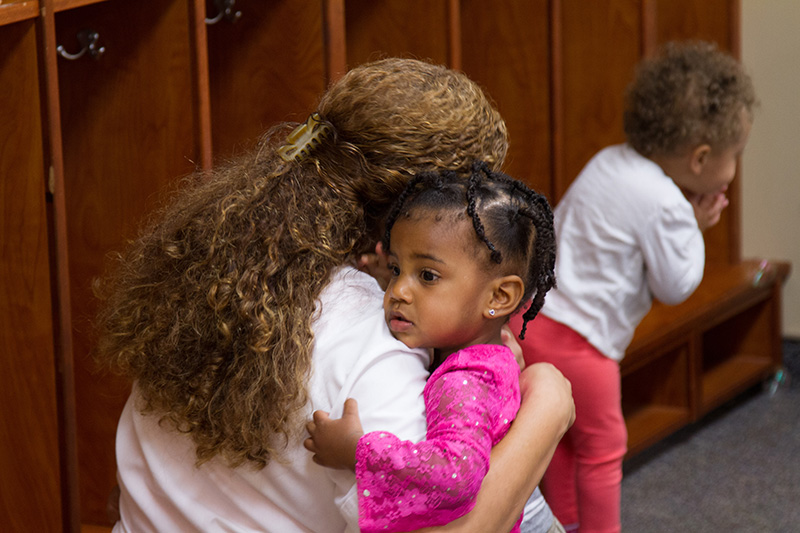
Greeting every child at the door by name can help to foster positive relationships. By acknowledging students at the start of each day, you can get a sense as to how they are feeling. A simple thumbs up (“I feel great!”), thumbs to the side (“I feel OK”), or thumbs down (“I’m in a bad mood”) provides children with a nonverbal way to tell adults how they are feeling and lets adults know which children may need a more formal check-in.
Communicate at Eye Level
When communicating with children, it is important to speak to them at eye level. Be sure to have their attention before giving a direction. Be sure to model the same behavior, such as appropriate eye contact and body language yourself.
Calm Demeanor
Maintain a calm demeanor when communicating with children, especially if the child is upset or acting out. Mirroring the child’s emotions can make matters worse and send the message that you are not in control of the situation.
Active Listening and Expressing Empathy
This is a way of communicating that involves restating or paraphrasing what was said to show that you are paying attention to the speaker. For example, if a child tells you, “I was playing with the video game first when Sam came over and took the controller from my hand and then pushed me out of the way!” you could say, “Sam took the game away from you and pushed you aside? I can see why that would make you upset.”
Genuine Interest in Child
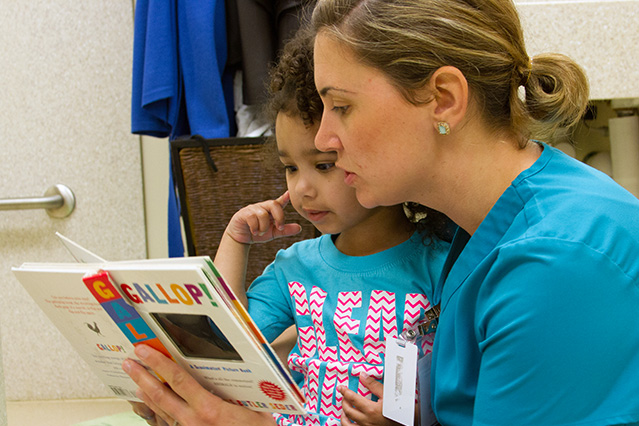
Expressing genuine interest in the experiences children share can help to build positive relationships. Take the time to actively listen, get at their level physically, and express excitement.
Positive Interactions
According to Wittmer and Petersen (2006), you should let children know that you will provide safe behavior boundaries and you will keep children, their peers, and their things safe. Adults who demonstrate and teach young children what to do, rather than what not to do, are not only keeping children safe, but also teaching them how to behave with others. Some examples of positive interactions include:
- Stating directions positively: Staff members should help children know what to do (“Walk please”) instead of what not to do (“No running”).
- Nonverbal cues of appreciation: Small, quick gestures like smiles, nods, a thumbs up or a pat on the shoulder can mean a lot to children and can help to improve positive relationships.
- Recognize efforts: Focusing on children’s positive efforts makes them more likely to continue exhibiting that behavior.
General Praise vs. Specific Feedback
Learning new social skills can be difficult, so it is important to recognize children’s efforts and accomplishments. Specific feedback, encouragement or praise is an important way to build relationships and help children learn. Specific feedback gives children information about their behavior. Examples include: “You gave Johnny a toy and now he’s excited,” “Thanks for giving Shandra a hug. She was very upset and that calmed her down,” or “You are waiting so nicely for your turn.” It is important to give specific praise that is timely whenever you see a child attempting to use a skill. This will not only help reinforce the child’s attempt at making a good choice, but can also help the child feel noticed and appreciated. Children notice when adults are responsive and caring.
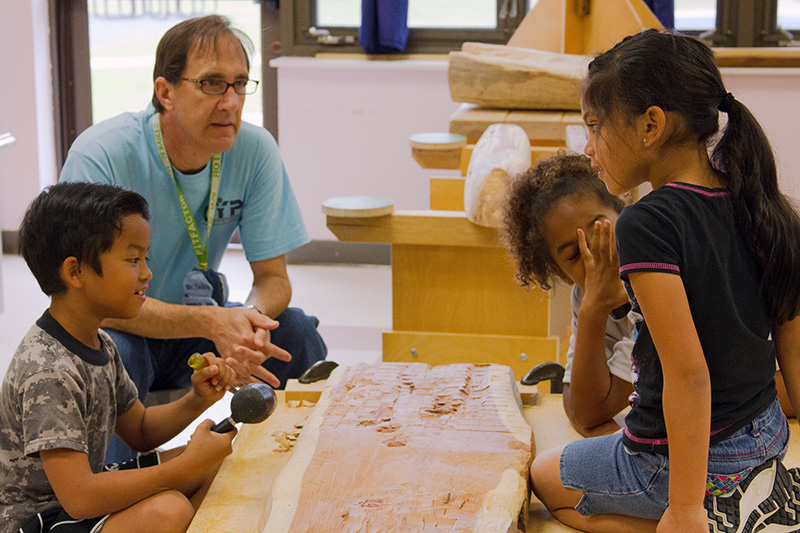
It is important to understand the difference between general and specific praise. General praise is generic. It can be directed toward a specific person or at no one in particular. Examples include “Great job!,” “Well done, Johnny,” “Good work.”
Specific praise is directed at an individual child and is specific in what is being praised. Examples include:
- Nice job explaining how to draw a flower, Suzy. Your advice really helped John with his project.
- William, I can see you've been practicing your singing. You sang that song beautifully!
- Pam, thanks for helping Kenneth pick up all the extra toys on the floor.
Sandwich (positive-negative-positive) technique for feedback: Negative feedback should be sandwiched between positive feedback. For example, “I’m glad you made it to circle on time, but running is not safe. Next time can you show me how responsible you are by walking?
Solicit feedback and provide opportunities for choice: Children love to give their opinions about things. Involve them in decisions and making choices to show that you trust their judgment and value their opinions.
Healthy Relationships With Families
Children learn to be social first and foremost as a member of their family. Families teach children about appropriate social behaviors and how to be social. Families and caregivers play an essential role in children’s social development. Involving families helps staff members understand and develop relationships with children. Research shows that children of families who are involved in their programs develop more positive attitudes and self-confidence. Family involvement can help staff incorporate the family’s values and traditions into the classroom activities. Also, involving the family in the classroom or program helps staff members understand what is happening in the home and encourages families to support and promote similar behaviors at home. The family-staff relationship also is an important model for children. Good family-staff relationships are fostered through good communication skills and mutual respect.
This video shares how one staff member builds relationships with families:
Providing Positive Feedback
Establishing and maintaining healthy relationships with families will help children be successful in the program and beyond. Families should be involved in all decision-making for their child. Ways families can be involved include:
- Communication about what is happening at home and in the program: Provide regular notes home, communication logs, and newsletters. Be sure staff members share positive information. See the Families course for more ideas.
- At-home ideas. Staff members can send ideas home that help children and families discuss social-emotional development. These ideas should be optional and presented as a fun thing the family can do together. For example, a preschool family might keep track of the number of compliments each family member gives in one evening. A school-age family might volunteer together at a community event or have dinner together one evening.
- Regularly scheduled family conferences. Make sure your program has regular times for staff and families to connect formally. Teach staff members how to facilitate these meetings. See the Families course for more information.
- Participating in family events. Your program should offer regular events for families. Whether these are breakfasts, movie nights, open houses, or other events, it is important to provide opportunities for families to get together socially.
- Volunteering in the program. Provide opportunities for families to give back to the program. Family members can coordinate staff appreciation events, read to children, plant a garden, run a fitness club for staff, or any number of other activities.
- 6. Providing input and community resources. Families are a valuable resource for your program. Provide ways for them to share information about themselves and about resources in the community.

Strategies to Involve the Family
There are many ways to involve families, and the families themselves should determine the extent to which they want to be involved in the program. However, staff members should ensure the program is warm and welcoming for all family members.
The following are examples of strategies for involving families:
- Create a brief weekly newsletter. Send paper copies home or email to families, depending on their preferred method of communication. In the newsletter, briefly describe the activities, topics, events, and menu for the week. This will give families something to talk about with their children.
- Set up a family resource library where families can share books, materials, videos or other parenting materials. Have a self-checkout system to allow families to checkout and return items at drop-off or pick-up.
- Have monthly or bimonthly family days. Invite parents to the classroom and have specific activities planned for families and children to do together. Plan fun art activities, games or outside play. Because not all families will be able to attend, have families work with pairs of children to ensure each child is working with a family member. Encourage family members to promote social interactions between the children.
- For child-development programs, develop a playlist of songs you often sing during group time or at transitions. Encourage families to listen at home and help children with the words. Ask families for their own songs to include in the classroom.
- Invite parents to come help in the program. If there are several parents who want to help, make a volunteer schedule and let parents take turns helping.
- Have family reading days in the winter or water play in the summer. Invite families to the program to read their favorite books with their children during winter months. During warmer months, invite families and siblings to the program for water play activities.
- Include pictures of the children and their families in the program. Encourage parents to bring in pictures throughout the year. Perhaps a family volunteer with a photography hobby (or business) would offer to take photos of children and families.
Healthy Relationships Between Staff
To be most effective at your job, you must be able to label and talk about your own emotions or feelings and the emotions or feelings of others. This is an essential part of leading others in a responsive way. These skills help you self-regulate and problem-solve, which are essential skills for a trainer or coach.
Recognize Emotion
The 6 Habits of Highly Empathic People
Roman Krznaric
The Greater Good Science Center at the University of California, Berkeley
- Cultivate curiosity about strangers. Talk to people outside of your typical social circle, and set a goal to talk to one stranger per week.
- Challenge prejudices and discover commonalities. Look for what you share with others rather than what divides. What do you have in common with each staff member in your program?
- Try another person’s life. Seek experiences that let you truly understand another person’s experiences. Try leading a classroom for a few days.
- Listen hard—and open up. Try to really listen when others talk. Notice the emotions, context and messages. Also make yourself vulnerable by sharing your own stories and emotions.
- Inspire mass action and social change. Empathy doesn’t stop with individuals. Think long term about the changes you can make in your program, community and country. Promoting empathy among children is one of the greatest things you can do for the future.
- Develop an ambitious imagination. Empathize with people you find the hardest to relate to. Perhaps there is a staff member who has radically different beliefs from you or a family that has different approaches to child rearing. By taking their perspectives, you will stretch your own ability to empathize and will build a stronger relationship
Active Listening and Respectful Speaking
Active listening is a cornerstone of communication and the first step in building healthy relationships with and between staff members. To truly understand an individual’s positions, interests, or motivation, you must listen. You should practice these strategies yourself and share them with staff:
- Furthering responses. These are the simple ways you let people know you are listening. Furthering responses include nodding your head, saying “Uh huh” or “what happened next?” and using the speaker’s words in your brief encouraging statements.
- Restating the speaker’s message. This is also known as paraphrasing. You might say, “Let me see if I understand correctly” and repeat what you heard in your own words.
- Reflecting the emotions of the speaker. An important part of communication is reading the emotions of others. You can show staff members you are listening and connecting with them by reflecting those emotions back to them. Simple phrases like, “I can tell that really upset you” or “I bet that was really disappointing” can encourage the speaker to continue sharing.
- Asking open-ended questions. “What” and “How” questions are powerful, nonjudgmental ways to help staff members communicate with you. They show you are engaged and actively listening. They also show that you want to hear the other person’s opinions. You might ask, “What happened with Sasha’s plan yesterday?” or “How is Davon doing with his asthma?”
- Summarizing the discussion. Any great conversation should end with a summary and a plan. You might say, “So I heard you say…,” “Let’s review our next steps… .”
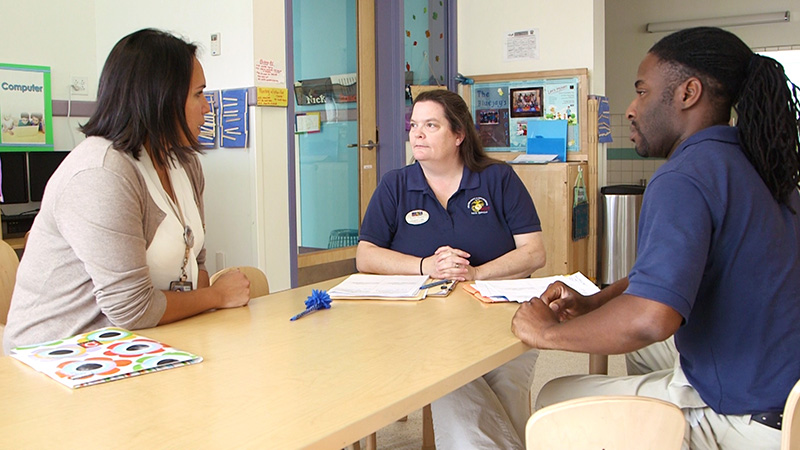
Listen as these training and curriculum specialists and classroom staff share advice on how to create healthy relationships amongst staff.
Healthy Relationships Amongst Staff
Conflict Resolution
At some point in your career, you will have to help settle a conflict. This might be a conflict between two staff members or it might be a conflict that you are involved in yourself. You can navigate these conflicts and preserve relationships through communication. As you learned in the Communication course, you must first think about the outcomes you want for yourself, the individuals in conflict, and your program. Next, think about any negative thoughts that are getting in your way. Then, try to open your mind for the conversation. As Stephen Covey writes in the Seven Habits of Highly Effective People, you should, “Seek first to understand, then be understood.” Worry less about getting your own point across and focus instead on understanding others’ positions and interests. Try to understand the root cause of the conflict. Ask clarifying questions to help guide yourselves to the important issues. If your communication partner becomes emotional or begins to vent, just keep listening. Take a supportive stance throughout the conversation. When handled well, difficult conversations can become safe spaces for adults to learn and grow.
Here are four key strategies for responding to conflicts in a healthy, relationship-building way:
- Recognize and manage your own stress. Conflicts can feel very threatening for both parties. Conflicts are more intense than simple disagreements. They can become emotionally charged and persistently stressful. Recognize stress in yourself and take steps to handle it appropriately before it can lead you to escalate the conflict. Take a deep breath. Step away from the situation and take a few minutes to notice everything around you in a mindful way (listen to the birds, feel the cool air on your skin, etc.). This can be calming.
- Remain aware of your emotional reactions to the situation. Seek to understand how you feel and why you feel this way. You can’t help settle a conflict if you don’t understand your role and the ways you feel.
- Pay attention to nonverbal communication. This means your own nonverbal communication and the nonverbal behavior of the other person. If you sense tension or anger, use strategies to diffuse the situation. Speak calmly and provide reassuring expressions.
- Focus on solving the problem rather than “winning.” It is less important to persuade the other person that your opinion is correct than it is to resolve a conflict. Compromise is the key to solve the problem.
- Learn about different conflict styles and how your background and experiences influence your responses to conflict.
Model
You interact with nearly everyone in a program on a daily basis: staff, children, families and management. This allows you to model healthy relationships:
- Be curious. Ask questions and seek to understand the people around you. Assume others are more interesting than you are. Build your empathy.
- Set personal goals to improve your communication. Practice active listening in every conversation. Talk to someone you don’t usually talk to once a week. Brainstorm a few interesting questions or conversation starters you can use with different people.
- Seek out your own professional development. Attend trainings or get coaching on your communication and conflict-resolution skills.
- Be aware of your own emotions. Talk about your emotions and make yourself vulnerable. It can feel silly or scary at first, but it becomes more comfortable over time. Practice incorporating emotions into things you say every day. Instead of saying, “I don’t have time,” you might say, “I’m feeling overwhelmed right now.” Instead of saying “Good for you,” you might say, “I’m relieved that worked out for you.”
- Manage your moods. Everyone feels intense emotions from time to time. Anger, frustration, disappointment, and fear are important emotions to express, but you should model appropriate ways to express them. Practice stepping away and taking deep breaths when something frustrates you in front of staff. Go for a short walk when you are having a hard time solving a problem.
Observe
You should prepare to observe the relationships between children, staff, and families in your program. The table below provides examples of incidents you might see in your program that threaten relationships. Read the scenario. Then reflect on what you might say and do to support the staff member.
Problem Solving Scenarios
Use the menu at the left or the pager below to cycle through scenarios
Scenario | TobyToby sits a screaming infant down in an infant seat. He walks away and says, “If she’s going to cry, I’m going to put her down. She just got fed and diapered. She is fine.” |
|---|---|
You Say | Say to the Staff Member:“If all her needs are met, sometimes babies just want held and comforted. This helps her know she’s safe here.” |
You Do | Take Action:Offer to rock the baby if the staff are too busy with other infants. Monitor staff for signs of stress. Provide a list of strategies to use if an infant won’t stop crying. |
Scenario | DanielDaniel has just entered the preschool program and has had a difficult transition. He cries easily and avoids other children. At the end of the day, you hear Daniel’s teacher, Miley, telling Daniel’s parents how much he cried and how he hid from other children. She sounds a bit disinterested. |
|---|---|
You Say | Say to the Staff Member:“Miley, tell me how Daniel and his family are doing. I’m wondering how they feel about the program right now.” |
You Do | Take Action:Offer to help Miley collect data on Daniel’s social behaviors so there is positive information to share with his family. |
Scenario | Jung-InJung-In was at snack in the school-age program. Another child spilled juice all over the table and it drenched Jung-In’s pants. He got upset and began belittling the child who spilled. The staff member, Mike, came over and told Jung-In to stop overreacting. He threw Jung-In some paper towels and walked away. |
|---|---|
You Say | Say...In the moment: “I can tell you’re pretty upset Jung-In, but it’s not OK to embarrass people. What do you need to get cleaned up?” After the event to Mike: “I could tell there were some emotions at the table today. What do you think was going through Jung-In’s mind?” “How do you think you could use that understanding of Jung-In’s thinking when you reacted?” |
You Do | Take Action:Model your own emotions when something frustrating happens. This will allow the staff members to see what should happen during stressful situations. Step in when you see an emotional situation. Label what you see and help brainstorm solutions. |
Scenario | BrittneyDuring a planning meeting with a program team, you notice Brittney suddenly become quiet and defensive. She stops participating in the planning and crosses her arms over her chest. She is avoiding eye contact and watching the clock. |
|---|---|
You Say | Say...“Brittney, I’m noticing that you seem unhappy with this process. What’s making you feel that way?” or “Let’s all take a second to check in with each other. What’s going well with this process and what is frustrating or needs to change?” |
You Do | Take Action:Write down Brittney’s feelings or the team’s suggestions. Follow-up after the meeting to talk individually with Brittney about her feelings and behavior. |
Explore
Use the Responsivity Checklist to observe staff members and document practices that specifically address staff responsiveness. Share your observations with staff and use the information learned from the checklist to identify goals and focus your coaching interactions.
Apply
You can be a resource for staff members as they build relationships with children and families. The Strategies for Building Relationships with Children handout is a resource for you. You can use it to get ideas or to share with staff members. Add this item to your resource library.
Demonstrate
Aguilar, E. (2018). Onward: Cultivating emotional resilience in educators. Jossey-Bass.
Covey, S. R. (2004). The 7 habits of highly effective people: powerful lessons for personal change. New York, NY: Golden Books.
Dombro, A.L., Jablon, J. & Stetson, C. (2020). Powerful interactions: How to connect with children to extend their learning. 2nd ed. Washington, DC: NAEYC.
Derman-Sparks, L., & J Edwards. J.O., & Goins, C.M. (2020). Anti-Bias education for young children and ourselves.2nd ed. Washington, DC: NAEYC.
Kznaric, R. (2012). The six habits of highly empathic people. University of California Berkeley: The Greater Good Science Center. http://greatergood.berkeley.edu/article/item/six_habits_of_highly_empathic_people1
Edwards, C. C., & Da Fonte, A. (2012). The 5-Point plan: Fostering successful partnerships with families of students with disabilities. Teaching Exceptional Children, 44, 6-13.
Fullan, M. (2002). The change leader. Beyond Instructional Leadership, 59, 16-21.
Hemmeter, M.L., Ostrosky, M., & Fox, L. (2021). Unpacking the pyramid model: A practical guide for preschool teachers. Brookes Publishing.
Jamison, K. R., Forston, L. D., & Stanton-Chapman, T. L. (2012). Encouraging social skill development through play in early childhood special education classrooms.Young Exceptional Children, 15(2), 3-19.
Jones, N. P. (2008). Grouping children to promote social and emotional development. Young Children, 63(3), 34-39.
Joseph, G. E., & Strain, P. S. (2003). You’ve got to have friends (Module 2; Handout 2.3: Social Emotional Teaching Strategies). The Center on the Social and Emotional Foundations for Early Learning. University of Illinois at Urbana-Champaign. http://earlyliteracylearning.org/TACSEI_CELL/project_files/content/level_3/pdf/3_10dCSEFELfriendsarticle.pdf
Lally, J.R. & Mangione, P. (2006).The uniqueness of infancy demands a responsive approach to care. Young Children, 61(4): 14-20.
Leyden, R., & Shale, E. (2012). What teachers need to know about social and emotional development. Camberwell, Australia: ACER Press.
Wittmer, D. S., & Petersen, S. H. (2006). Infant and toddler development and responsive program planning: A relationship-based approach. Upper Saddle River, NJ: Merril Prentice-Hall.


